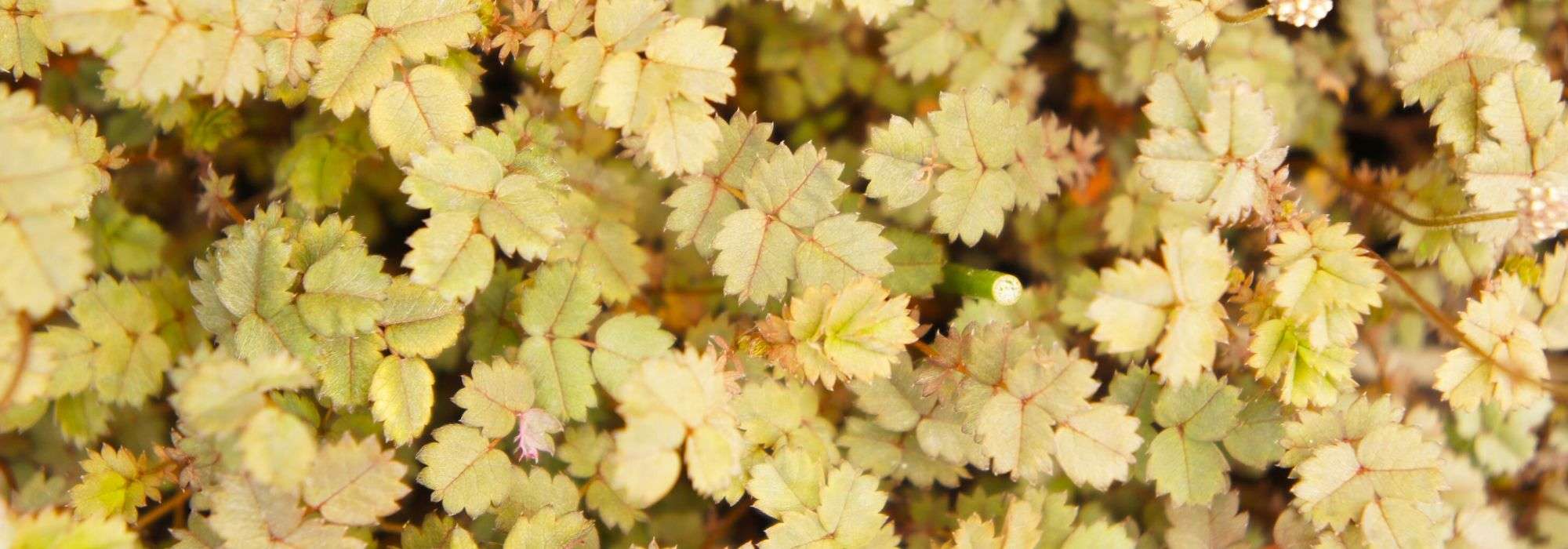
Acaena, also known as the New Zealand burr, is a charming plant that can add texture and interest to your garden. Here’s how to plant and grow it successfully. ### Planting Acaena 1. **Location**: Choose a sunny to partially shaded spot in your garden. Acaena thrives in well-drained soil. 2. **Soil Preparation**: Ensure the soil is rich in organic matter. You can mix in compost to improve soil quality. 3. **Spacing**: Space the young plants about 30 cm apart to allow for their spreading habit. 4. **Planting**: Dig a hole slightly larger than the root ball of the plant. Place the plant in the hole, backfill with soil, and water thoroughly. ### Growing Acaena 1. **Watering**: Keep the soil consistently moist, especially during dry spells. However, avoid waterlogging. 2. **Fertilising**: Apply a balanced fertiliser in spring to promote healthy growth. 3. **Pruning**: Trim back any dead or damaged foliage to encourage new growth. 4. **Pests and Diseases**: Watch for common pests like aphids. Treat infestations promptly with appropriate measures. With the right care, Acaena can be a delightful addition to your garden, providing ground cover and unique foliage throughout the growing season.
Contents
Acaena in a nutshell
- Acaena or lampourde forms an evergreen and original groundcover
- It has small, finely cut foliage of great delicacy and wonderful colour
- Its globular, spiky fruit punctuates its carpet-like tuft at the end of summer
- Easy to grow, very hardy and low maintenance, it prevents weeding!
- It is an accommodating young plant that thrives in almost any soil
- Install it between paving stones, at the edge, or in not too dry rockeries
A word from our expert
Acaena or Bursaria forms a vigorous and original evergreen groundcover, with discreet summer flowering followed by bristly fruits that are highly decorative in coppery red or golden hues.
This dense cushion comes in various colours depending on the species and varieties: blue-green in Acaena buchananii, pale blue-grey in the Acaena ‘Blue Haze’, bronze green in the Acaena microphylla ‘Kupferteppich’, or purple in the Acaena inermis ‘Purpurea’.
Delicate yet non-invasive, this small perennial adapts to almost any well-drained soil that is not too dry in summer. It slips between paving stones, fills a rockery, highlights a border, or replaces lawn in lightly trafficked areas.
Discover our Acaenas, which are beautifully delicate and even lovely in winter; they will not disappoint you!
Description and Botany
“`html
Botanical data
- Latin name Acaena
- Family Rosaceae
- Common name Bursaria
- Flowering May-September depending on varieties
- Height 3 to 10 cm
- Exposure Sun, Partial shade
- Soil type well-drained, moist
- Hardiness -15 to -34°C
Acaena or Bursaria, is a perennial groundcover from the Rosaceae family, a relative of burnet. The genus Acaena comprises around 150 species native to the meadows of temperate regions, most often from New Zealand or the southern Andes. Among the most common species and varieties, we find: Acaena buchananii, or Buchan’s Bursaria, which is the smallest in the genus, Acaena microphylla, or Small-leaved Bursaria with its tiny foliage, and Acaena magellanica (syn. Acaena glaucophylla).
Acaena spreads as a dense groundcover, reaching heights of 3 to 10 cm, with a spread of approximately 30 to 60 cm (theoretically with no limit to expansion), using creeping stems or rootstocks. The plant roots itself in various places, similar to strawberries, generating new shoots in multiple directions. It grows quickly, spreading over time but is not invasive as its expansion is easily manageable. It eventually forms a persistent carpet in mild climates.
Bursaria is one of those perennial plants characterised by remarkable foliage reminiscent of burnet. It consists of alternate, compound leaves finely divided into leaflets that do not exceed 3 to 7 mm in diameter. The foliage is sometimes pubescent on the underside.
Their colour varies from one cultivar to another, ranging from silvery light green, to blue-green in Acaena buchananii, to bronze green in Acaena microphylla, to purplish hues, and pale blue-grey. Among the notable cultivars, Acaena inermis ‘Purpurea’ is a lovely form with purple foliage, Acaena ‘Blue Haze’ is a hybrid Bursaria with a very soft blue colour, while Acaena microphylla ‘Kupferteppich’ stands out with its tiny pink-washed green foliage.
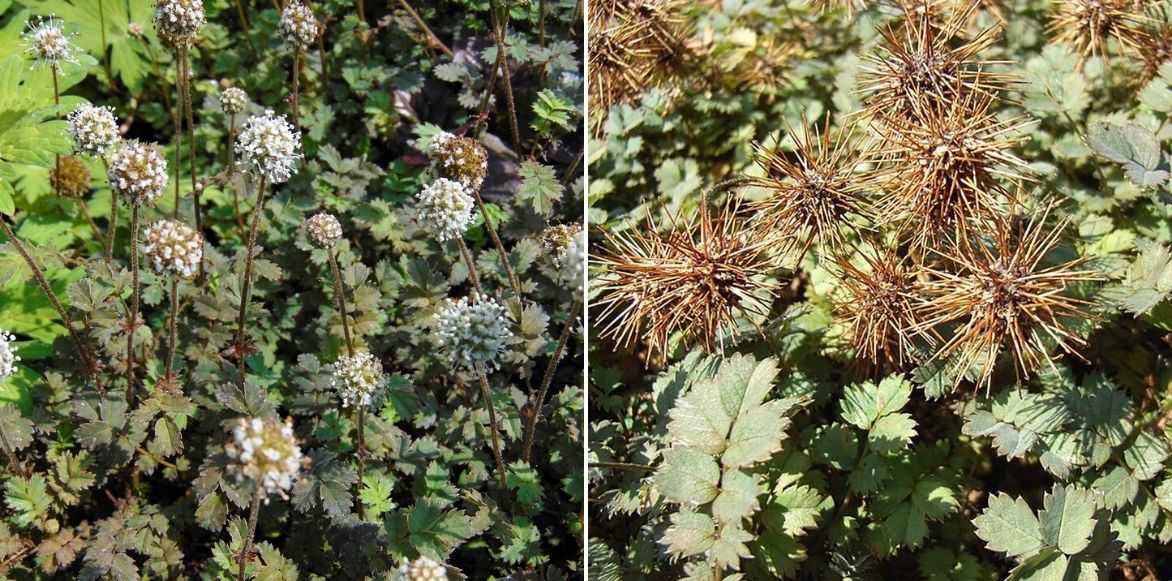
Evolution of the flowering of Acaena microphylla
From May-June to September, depending on the species, upright flowers in the shape of small spheres emerge from this mass of tiny leaves. They bloom as heads or in cylindrical spikes that are white to greenish, sometimes purple. This discreet flowering attracts pollinators.
By late summer, they transform into attractive fruit; achene approximately 2 cm in diameter resembling small chestnuts or sea urchins. These curious, globose fruits detach above the foliage and are covered in spiny hairs without being prickly. They offer a lovely decorative hue in autumn, ranging from dark pink, reddish-brown, coppery, ochre, to golden, and easily attach to clothing and animal fur.

Bursarias offer several foliage colours: A. inermis ‘Purpurea’, A. ‘Blue Haze’, and A. buchananii ‘Silver Green’
With good hardiness, Bursaria is not afraid of the cold and can withstand negative temperatures below -15°C. This small plant is highly valued in rockeries, between paving stones, at the edges, in borders, or as groundcover at the base of bushes.
“`
Main species and varieties
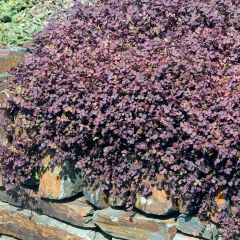
Acaena inermis Purpurea
- Flowering time July, August
- Height at maturity 10 cm
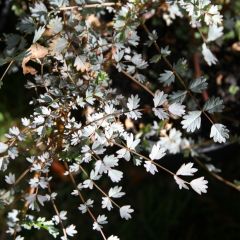
Acaena saccaticupula Blue Haze
- Flowering time July, August
- Height at maturity 10 cm
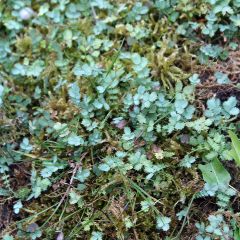
Acaena buchananii
- Flowering time June, July
- Height at maturity 5 cm
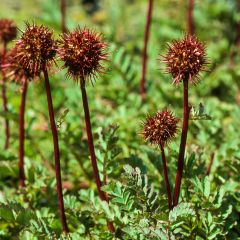
Acaena magellanica
- Flowering time July, August
- Height at maturity 10 cm
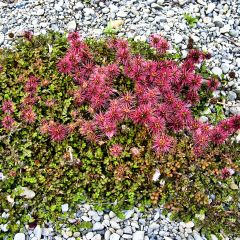
Acaena microphylla Dichte Matte
- Flowering time July, August
- Height at maturity 10 cm
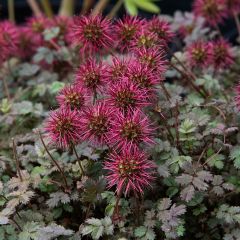
Acaena microphylla Kupferteppich
- Flowering time July, August
- Height at maturity 10 cm
Discover other Acaena
View all →Available in 1 sizes
Available in 1 sizes
Available in 1 sizes
Available in 1 sizes
Available in 2 sizes
Available in 1 sizes
Available in 1 sizes
Planting
Where to plant Acaena?
Perfectly hardy, the Acaena is a small perennial that is easy to care for, better able to withstand cold (down to -15/-20°C, sometimes even -35°C depending on the varieties) than drought. It does not appreciate very dry summers at all, and its cultivation may be more challenging in a Mediterranean climate. Accommodating, it thrives in almost any well-drained soil, even poor, rocky, or calcareous soils, provided they are healthy in winter and remain cool in summer (but not waterlogged). It enjoys a sunny to slightly shaded exposure.
The clumps grow larger over time but remain easy to control.
Non-invasive, it slips between paving stones, along a border, enriches a sunny rock garden, quickly colonises shrub beds even in winter. It can also be planted in an alpine garden to create planters, pots, or bowls from which it will willingly escape.
This vigorous groundcover can replace lawn in low-traffic areas and also helps to limit the proliferation of weeds once established. It is also an interesting plant for use on roofs or on a green wall, in cooler climates, however.
When to plant it?
Planting Acaena is done in autumn from September to November or in spring from February to April, avoiding periods of frost and drought.
How to plant it?
In open ground
Count 3 to 7 plants per m² depending on the varieties for a dense carpet.
- Dig a hole 3 to 5 times wider than the root ball
- In heavy soils, incorporate compost and sand into the planting hole
- Create a drainage layer
- Place the plant in the centre of the hole
- Cover the root ball
- Firm the soil
- Water generously and then regularly until it takes root
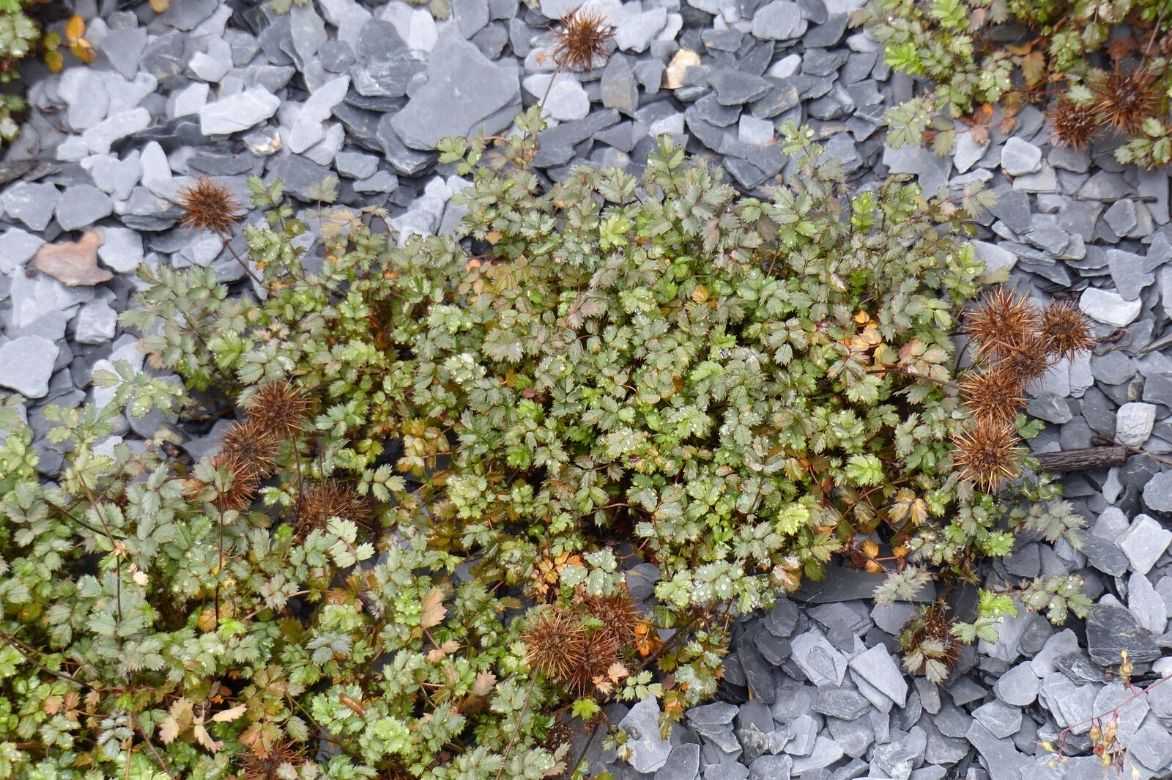
The Acaena is perfect as groundcover!
Maintenance and Care
Whether in pots or in the ground, it is essential to keep the soil moist, especially in summer, or you risk seeing this perennial wilt and decline: water regularly in the first year after planting, then 1 to 2 times a week.
If you wish to limit its spread, pull out the excess rooted stems.
Multiplication
If Acaena is propagated by sowing, multiplying by division of clumps or detaching rooted stolons is simpler.
- In early autumn or spring, use a fork to lift part of the clump
- Divide it into several rosettes, each with roots and a few leaves
- Replant the divisions immediately in the garden or in pots
You can also dig up the stolons: simply take the naturally rooted stems to replant them further away in moist soil.
→ Ingrid tells you more in: How to propagate Acaena or lampourde?
Associate
With its evergreen foliage in light or deep shades, the Lampourde is perfect for beautifully filling the space beneath trees and bushes, in paving, shaded border beds, or a fresh, sunny rockery.
To create a carpet of subtle colours and textures at the base of bushes, or in a border, pair it with Ruine-de-Rome (Cymbalaria muralis), heucheras, or hardy geraniums.
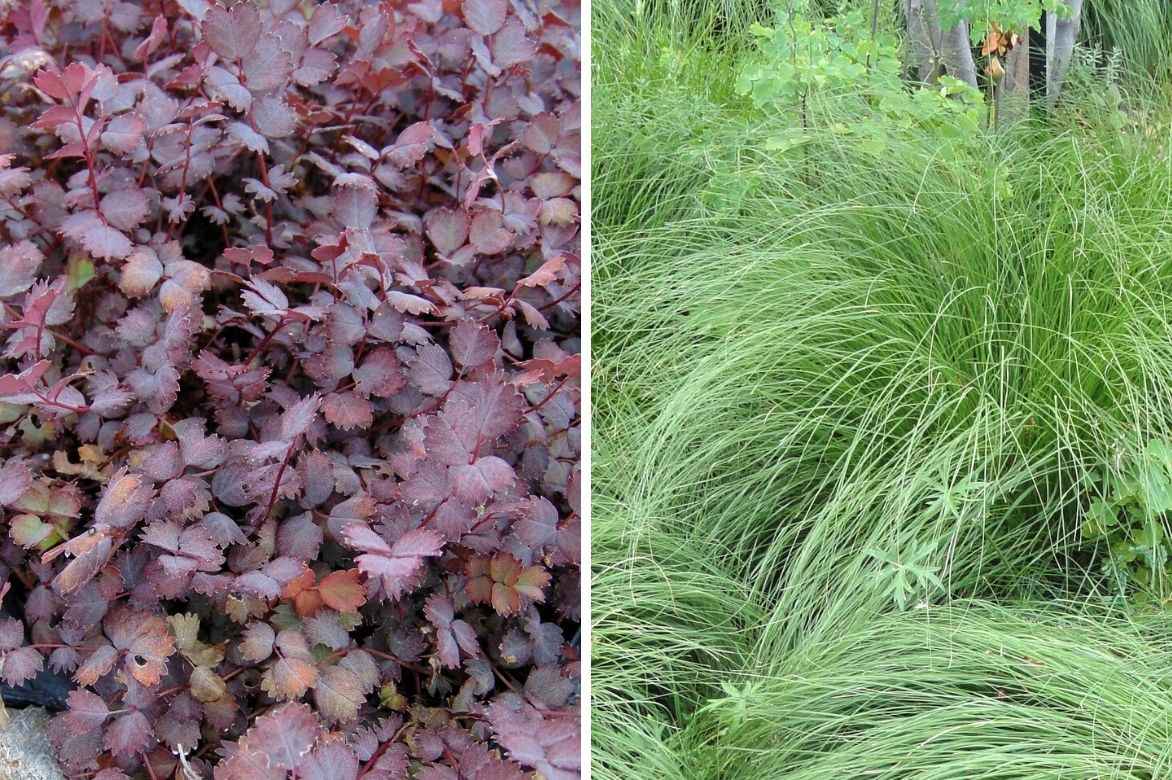
An example of association: Acaena inermis ‘Purpurea’ will form a superb carpet with some clumps of Sporobulus heterolepis
For the rockery, mix it with grasses or other evergreen groundcover perennials that thrive in the same growing conditions, such as Caucasian rockcress, aubrietas, sweet William, or Spanish lawn. It also pairs well with small sedums, houseleeks, or saxifrages.
It creates a colourful display with many spring bulbs like tulips.
Purple-leaved lampourdes like Acaena ‘Purpurea’ will look wonderful with silky grasses such as Sporobulus or vibrant colours like Imperata cylindrica ‘Red Baron’, Pennisetum setaceum ‘Rubrum’, and Miscanthus sinensis ‘Little Miss’.
→ Discover more pairing ideas with Acaena in our advice sheet!
Useful resources
- What good groundcover as an alternative to lawn?
- What to plant under my trees?
- Subscribe!
- Contents
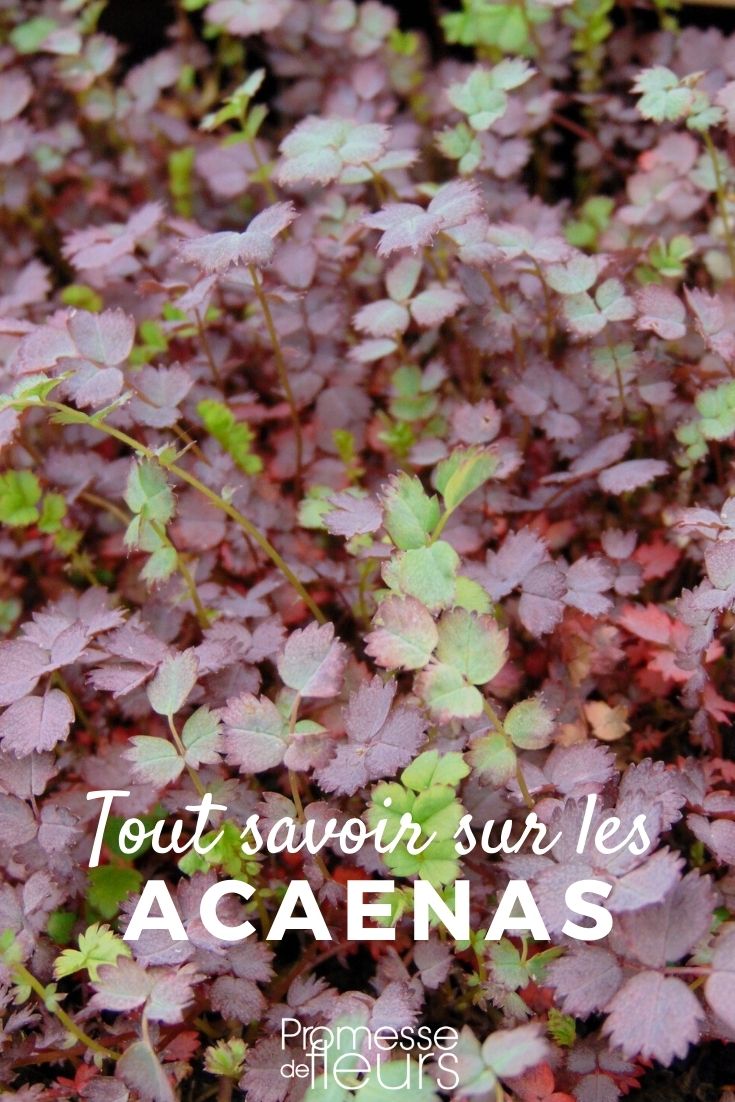



































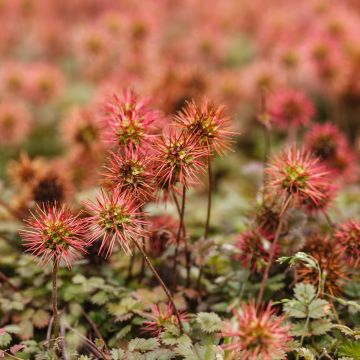

Comments